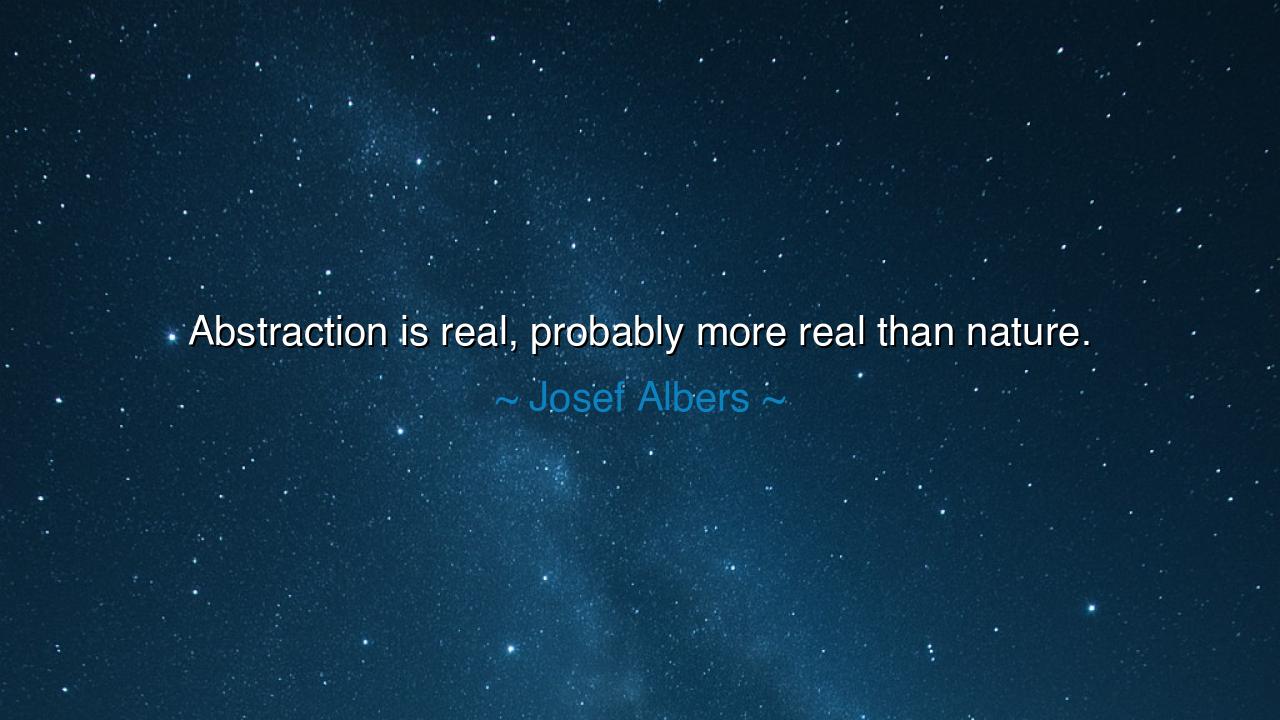
Abstraction is real, probably more real than nature.






Hear now the words of Josef Albers, master of color and form, who proclaimed: “Abstraction is real, probably more real than nature.” At first hearing, this seems a paradox, for do we not touch the earth, see the sky, taste the fruit of the vine? And yet Albers tells us that beyond these fleeting appearances lies a reality more enduring, more essential, more eternal. For nature shifts and decays, but abstraction—the pure order of line, the eternal harmony of proportion, the truth of relationships unseen—remains unbroken, untouched by time’s hand.
The ancients knew this truth long before Albers gave it voice. Plato taught of the Forms, saying that the visible world is but a shadow cast by eternal ideals. A tree may fall and rot, yet the Form of “tree” is eternal. The mountains crumble, yet the essence of triangle, of height and proportion, remains forever. So Albers echoes this ancient wisdom: that abstraction—which is not bound to the accidental shapes of the world, but to its eternal principles—is indeed more real than the fragile matter we behold.
Consider the work of the builders of the Great Pyramids of Egypt. The stones themselves have weathered; their faces once smooth are now scarred. Yet the abstraction of the pyramid—the idea of ascending form, of four sides converging to the heavens—remains timeless. Even if the stones were dust, the concept they embodied would live in the mind, indestructible. This is what Albers reminds us: that behind every object of nature, there is an invisible truth, and it is this truth that endures when the object itself perishes.
Albers himself lived in the realm of color. He showed his students that a hue is never alone, but changes according to its relation with others. Here again lies abstraction: the recognition that the essence of color is not in the pigment, not in the fleeting light of day, but in the eternal relationships of contrast, harmony, and balance. One sees green not only because of green itself, but because of red beside it, or yellow above it. Thus, to perceive through abstraction is to see more deeply than the senses alone will allow.
But let us also see the heroic struggle in these words. For man is often blinded by nature—by the brute insistence of what the eye sees, the ear hears, the hand touches. He mistakes the fleeting for the eternal, the surface for the depth. Albers calls us higher: to seek the real not in what changes, but in what abides. To see abstraction is to pierce through appearances and recognize that truth is found not in matter, but in the pattern that shapes it.
The warning is clear: if you live only by the surface of things, you live as one who builds upon sand. But if you grasp the abstractions that underlie them—the principles of harmony, the laws of proportion, the eternal relationships—then you stand upon rock. For the leaf will fall, the river will change its course, the face will wrinkle and fade, but the truths of number, balance, and essence will remain.
Therefore, O seekers of wisdom, cultivate the eye of abstraction. Do not be deceived by the glamour of the surface. When you look upon a painting, seek not only its subject, but its structure. When you read a poem, seek not only the tale, but the rhythm that carries it. When you live among men, see not only their forms, but the patterns of their loves, fears, and desires. For it is in these unseen structures that reality reveals itself most powerfully.
Practical counsel I give: train your mind daily in perceiving the eternal through the fleeting. Study geometry, for it reveals the harmony that underlies all forms. Meditate upon art, not as ornament, but as a window into essence. Seek to perceive the abstract laws that shape human life—justice, harmony, balance—and live by them. In doing so, you will dwell not in the shadows of nature, but in the enduring light of reality, where truth cannot be shaken and where beauty abides forever.






AAdministratorAdministrator
Welcome, honored guests. Please leave a comment, we will respond soon